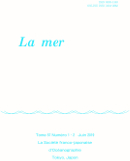Little is known about the early life history of critically endangered salangid,
Salanx ariakensis, being one of the largest species in salangids, endemic to Ariake Bay in Japan. When surveying fish larvae and juveniles by a larva net and a beam trawl in Ariake Bay during spring tide period of December 2017, the larva net could yield a total of 10 yolk-sac, 10 preflextion, seven flextion and four postflextion larvae. No larvae occurred in any stations of rivers, and particularly the yolk-sac and preflexion larvae had been aggregated in waters around the mouth of
each river. After starting the notochord flexion, they had tended to disperse westward along coasts with growth by the residual current, and to be nursed in shallow coasts with relatively polyhaline and less turbid waters for Ariake Bay. These phenomena could be found also in autumn of 2014, 2015 and 2016. Considering these information, it is likely that
S. ariakensis spawn in the vicinity littorals of estuaries rather than the upper reach of rivers, as well as common salangid,
Salangichthys microdon.
抄録全体を表示
